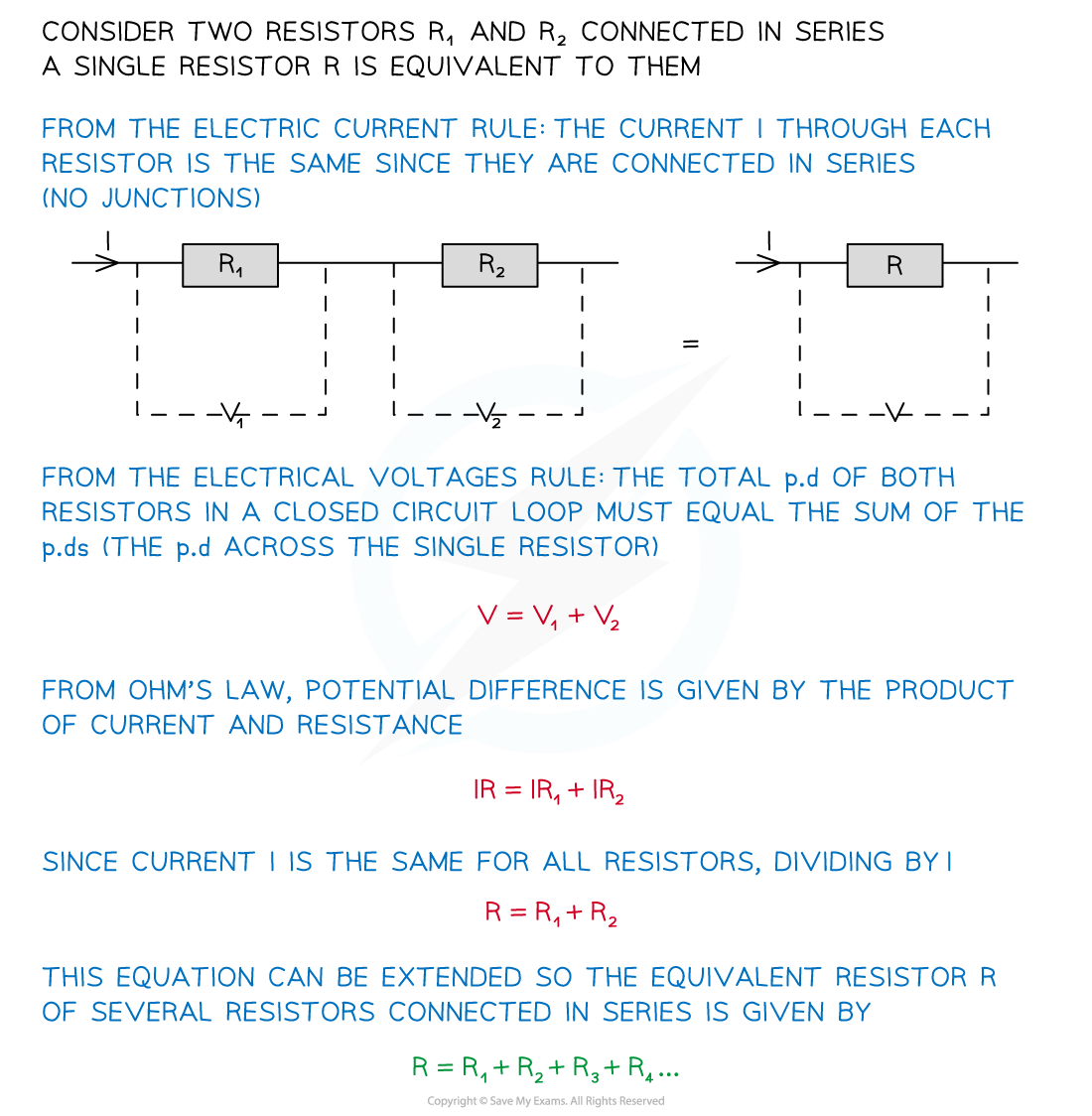Series & Parallel Circuits (DP IB Physics) : Revision Note
Series & Parallel Circuits
Resistors in Series
In a series circuit:
The current is the same at any point
The potential difference is split across all components depending on their resistance
When two or more components are connected in series:
The combined resistance of the components is equal to the sum of individual resistances
Three resistors connected in series will have a total resistance of R = R1 + R2 + R3

Resistors in series
The equation for the total resistance of resistors in series is derived using the above rules for current and potential difference:

The equation for the combined resistance of resistors in series is therefore:

This means the total resistance increases
The combined resistance is more than the resistance of any of the individual components
For example, if two resistors of equal resistance are connected in series, then the combined resistance will double

Connecting more resistors in series increases the overall resistance
Resistors in Parallel
In a parallel circuit:
The total current is equal to the sum of the currents in each parallel branch of the circuit
The potential difference is the same across each loop
In a parallel circuit, the combined resistance of the components requires the use of reciprocals
The reciprocal of the combined resistance of two or more resistors is the sum of the reciprocals of the individual resistances
Two resistors connected in parallel will have a total resistance of

Resistors in parallel
The equation for the total resistance of resistors in parallel is derived using the above rules for current and potential difference:

The equation for the combined resistance of resistors in parallel is therefore:

This means the total resistance decreases
The combined resistance is less than the resistance of any of the individual components
For example, if two resistors of equal resistance are connected in parallel, then the combined resistance will halve

Connecting more resistors in parallel decreases the overall resistance
Summary of the rules in series and parallel circuits
The table below summarises the rules for calculating current, potential difference and resistance within series and parallel circuits
Series and Parallel Circuits Summary

Worked Example
For the circuit below, state the readings of ammeters A1, A2 and A3.

Answer:
Step 1: Recall the rules for current in series & parallel
In a series circuit: The current is the same at any point
In a parallel circuit: The total current is equal to the sum of the currents in each parallel branch of the circuit
Step 2: Determine the current in ammeter A1
Ammeter A1 is in series with ammeter A
Therefore, the current in A1 = the current in A
A1 = 0.270 A
Step 3: Determine the current in ammeter A3
The current from ammeter A1 enters splits into two branches
One branch has a current of 80 mA = 0.080 A
The current in the other branch is the reading of ammeter A3
0.270 = 0.080 + A3
A3 = (0.270 – 0.080) = 0.190 A
Step 4: Determine the current in ammeter A2
The current of 0.080 A splits into two branches
One branch has a current of 27 mA = 0.027 A
The current in the other branch is the reading of ammeter A2
0.080 = 0.027 + A2
A2 = (0.080 – 0.027) A = 0.053 A
The current readings of the three ammeters are:
A1 = 0.270 A = 270 mA
A2 = 0.053 A = 53 mA
A3 = 0.19 A = 190 mA
Worked Example
For the circuit below, state the readings of the voltmeters V1, V2 and V3.
All the lamps and resistors have the same resistance.

Answer:
Step 1: Recall the rules for p.d. in series & parallel
In a series circuit: The potential difference is split across all components (equally if the resistance is equal)
In a parallel circuit: The potential difference is the same across each loop
Step 2: Determine the p.d. in voltmeter V1
The potential difference provided by the cell is the total input p.d., so, each loop must sum to 24 V
The first loop consists of the 2 V lightbulb, the 12 V lightbulb and resistor V1
2 + 12 + V1 = 24 V
V1 = 24 – 2 – 12 = 10 V
Step 3: Determine the p.d. in voltmeter V2
The second loop consists of the 2 V lightbulb, the 8 V resistor, lightbulb V2, and the 8 V lightbulb
2 + 8 + V2 + 8 = 24 V
V2 = 24 – 2 – 8 – 8 = 6 V
Step 3: Determine the p.d. in voltmeter V3
The third loop consists of the 2 V lightbulb and resistor V3
2 + V3 = 24 V
V3 = 24 – 2 = 22 V
The potential difference readings of the three voltmeters are:
V1 = 10 V
V2 = 6 V
V3 = 22 V
Examiner Tips and Tricks
The equations for current, potential difference and resistance in series and parallel circuits is given in your data booklet. However, it is much quicker if you remember them!

You've read 0 of your 5 free revision notes this week
Sign up now. It’s free!
Did this page help you?
